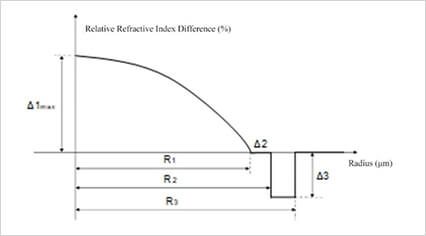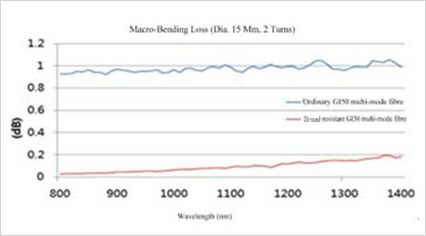Multimode Fibres
Evolution and Application Prospects
Abstract: The increasing transmission rate in data centers has set a higher demand on the performance of multimode fibres which developed towards high bandwidth, bending resistance, and multiple wavelengths. The combination of multimode fibres and VCSELs is still the most cost-effective solution for high-speed interconnection within short ranges. In the future, the combination of parallel optics technology and SWDM technology is the major application scheme of multimode fibres.
Keywords: Data center, Multimode fibre, OM5, SWDM
Multimode fibres are mainly used in data centers. Statistics show the bandwidth requirements for optical interconnections in large data centers have almost doubled every two years. This speed is unmatched by access networks, metropolitan area networks, and backbone networks. The 400 Gbit/s optical transceivers were first used in the data center. The 400 Gbit/s Ethernet standard of 400GBASE-SR16, 400GBASE-SR8 and 400GBASE-SR4.2 for multi-mode fibres have been released.
Driven by the increasing transmission rate, the applications of multimode fibres have witnessed three important changes in recent years. Firstly, the single wavelength rate has reached 25 Gbit/s and 50 Gbit/s; secondly, the Parallel Optics Technology using MPO connectors has been widely used; thirdly, the industry chain related to Shortwave Wavelength Division Multiplexing (SWDM, shown in Figure 1) has become mature gradually. All of these changes have put forward new requirements for multimode fibres, especially the geometry and bandwidth performance of multimode fibres, and the consistency and uniformity of products.

Figure 1 Shortwave Wavelength Division Multiplexing (SWDM)
Related Ethernet Standards
Over the past decades, the multimode fibre industry has been highly associated with the vertical cavity surface emitting laser (VCSEL) industry. The IEEE 802.3 series Ethernet standards have consolidated multimode fibres and VCSELs to constitute a variety of transmission solutions.
From OM1 to OM5, multimode fibres have evolved to the fifth generation. The specifications are as shown in Table 1. The OM3 to OM5 fibres are designed with VCSELs as the light source and add effective modal bandwidth as a characteristic. The international standard for OM5 fibres was released by ISO/IEC in 2017, with an additional bandwidth of 953 nm, laying a foundation for shortwave wavelength division multiplexing (SWDM).
| Category | Core Diameter (μm) |
Min.Effective Modal Bandwidth (MHz.km) |
Min.Overfilled Launch (MHz.km) |
|||
|---|---|---|---|---|---|---|
| 850nm | 953nm | 850nm | 953nm | 1300nm | ||
| OM1 | 62.5 | / | / | 200 | / | 500 |
| OM2 | 50 | / | / | 500 | / | 500 |
| OM3 | 50 | 2000 | / | 1500 | / | 500 |
| OM4 | 50 | 4700 | / | 3500 | / | 500 |
| OM5 | 50 | 4700 | 2470 | 3500 | 1850 | 500 |
Table 1 Main Characteristics of Multimode Fibres
According to the IEEE 802.3 series Ethernet standards, the transmission distances of OM3 to OM5 fibres in the 10 Gbit/s to 400 Gbit/s systems are shown in Table 2. The parallel optics technology and SWDM technology are adopted in the 40 Gbit/s, 100 Gbit/s, and 400 Gbit/s systems.
| Rate(Gb/s) | Standard | Wavelength (nm) |
Bidirectional Communication Fibre |
Max.Transmission Distance | ||
|---|---|---|---|---|---|---|
| OM3 | OM4 | OM5 | ||||
| 10 | 10GBASE-SR | 850 | 2 | 300 | 550 | 550 |
| 25 | 25GBASE-SR | 850 | 2 | 70 | 100 | 100 |
| 40 | 40GBASE-SR4 | 850 | 8 | 100 | 150 | 150 |
| 100 | 100GBASE-SR4 | 850 | 8 | 70 | 100 | 100 |
| 100GBASE-SR10 | 850 | 20 | 100 | 150 | 150 | |
| 400 | 400GBASE-SR16 | 850 | 32 | 70 | 100 | 100 |
| 400GBASE-SR8* | 850 | 16 | 70 | 100 | 100 | |
| 400GBASE-SR4.2* | 850, 910 | 8 | 70 | 100 | 150 | |
Table 2 Ethernet Standards for OM3 to OM5 Fibres
* Source: The latest IEEE 802.3cm published in January 2020.
The development of multimode fibres has showed three major tendencies in terms of performance: high bandwidth, bending resistance, and multi-wavelength.
High bandwidth is mainly achieved by optimizing the preparation technology, fibre refractive index profile and material composition. The optical fibre preform manufactured by the PCVD process, which is also the best choice for manufacturing high bandwidth multimode fibres. Preform is composed of thousands of deposited layers and presents a precise refractive index distribution.
Bending resistance is achieved by designing the refractive index profile of the depressed inner cladding, as shown in Figure 2. The comparison of the macro-bending performance between bend-resistant multimode fibres and traditional multimode fibres is shown in Figure 3. The significant improvement in bending resistance provides higher reliability for complex dense cabling in data centers.

Figure 2 Refractive Index Profile of
Bend-Resistant Multimode Fibres

Figure 3 Comparison of Macro-Bending Performance between
Bend-Resistant Multimode Fibres and Traditional Multimode Fibres
The OM5 fibre is the first standardized multimode fibre that focuses on multi-wavelength applications. There were already many reports on transmission tests of OM3 to OM5 fibres at wavelengths other than 850 nm. Some companies and scientific research institutions have mainly carried out transmission tests at 880 nm, 910 nm, 940 nm, 980 nm, and 1060 nm wavelengths. The results show that in the 880 to 1060 nm wavelength range, the transmission distance of the OM5 fibre is obviously longer than that of the OM4 fibre. The development of multimode fibres for multi-wavelength applications and related VCSELs is still in an initial stage. In the future, we will go deep into the development in this field.
The combination of multimode fibres and VCSELs is still the most cost-effective solution for high-speed interconnection within short ranges. The combination of parallel optics technology and SWDM technology can greatly increase the transmission capacity of multimode fibre systems, providing a solution for high-speed transmission in data centers. Therefore, great prospects can be expected for multimode fibres. The coverage of multimode fibres, especially high-end multimode fibres (OM3 to OM5 fibres) will enjoy a sustainable growth. The SWDM industry chain will gradually become mature in the coming years, and the SWDM technology will also be applied on a large scale in the next few years. The demand for the OM5 fibres will grow rapidly.
